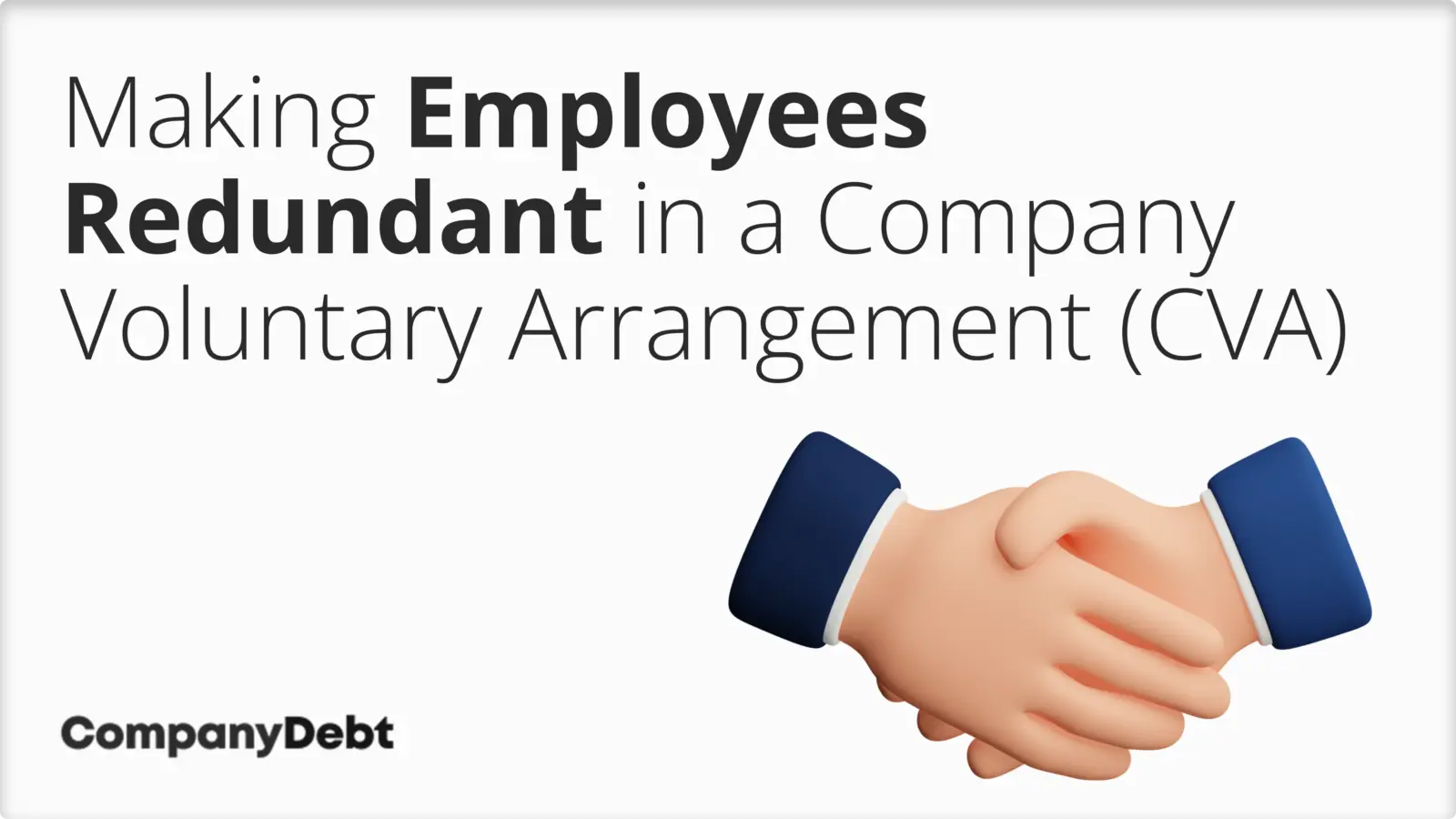
Making Employees Redundant in a Company Voluntary Arrangement (CVA)
While a Company Voluntary Arrangement (CVA) allows you to restructure your debts and continue trading, it often requires tough decisions, including redundancies.
As a business owner, you’re likely concerned about how a CVA might affect your employees. We understand that making staff redundant is never easy, but it’s sometimes necessary to ensure the long-term survival of your business.
In this article, you’ll learn:
- The legal requirements you must follow
- How redundancy costs are handled in a CVA
- Your employees’ rights and entitlements
- Alternatives to consider before making redundancies
We’ll also explore how redundancies can impact your CVA proposal and the long-term considerations for your business.

Legal Considerations for Redundancies in a CVA
When making redundancies as part of a CVA, you must adhere to UK employment law. Failing to do so could result in costly unfair dismissal claims, potentially jeopardising the CVA’s success.
Firstly, you need to follow proper redundancy procedures. This includes:
- Identifying which roles are at risk
- Using fair selection criteria
- Providing adequate notice periods
- Offering suitable alternative employment where possible
Consultation requirements are particularly crucial.
The ‘Woolworths case’ (USDAW v WW Realisation 1 Ltd, 2015), ruled on by the European Court of Justice, clarified that collective consultation is required when proposing to dismiss 20 or more employees at one ‘establishment’ within 90 days.
This involves consulting with employee representatives at least 30 days before the first dismissal (45 days if 100 or more redundancies are planned). An ‘establishment’ typically refers to the local unit where employees work, which may not always be the entire company.
For smaller-scale redundancies, you should still hold individual consultations. These meetings allow you to explain the situation, explore alternatives, and address any concerns your employees may have.
It’s essential to document all aspects of your redundancy process thoroughly. This includes recording your rationale for selecting particular roles or individuals for redundancy and maintaining minutes of consultation meetings.
Remember, employees in a CVA have the same rights as those in any other business situation. They can still claim unfair dismissal if proper procedures aren’t followed. To protect your business, ensure you have a clear, fair, and well-documented redundancy process in place.
If you’re unsure about any aspect of the legal requirements, it’s wise to seek advice from an employment law specialist.
What are the Financial Implications of Redundancies in a CVA?
Clearly, redundancy costs can significantly impact your CVA proposal and your company’s ability to meet its obligations.
Redundancy payments typically include:
- Statutory redundancy pay (for employees with at least two years’ service)
- Notice pay
- Outstanding holiday pay
- Any contractual redundancy entitlements
In a CVA, these costs are treated as preferential debts, meaning they take priority over unsecured creditors. However, you might not have to bear the full financial burden immediately.
The Redundancy Payments Office (RPO) plays a vital role here. If your company can’t afford to make the redundancy payments, the RPO can step in to pay employees directly. These payments then become a preferential debt in your CVA, to be repaid over the course of the arrangement.
This approach can help you manage cash flow in the short term, spreading the cost of redundancies over the duration of your CVA.
It’s worth noting that while the RPO can cover statutory payments, your company would need to pay for any enhanced redundancy packages you’ve offered.
When calculating the financial impact of redundancies, consider not just the immediate costs, but also the long-term savings in wages and associated expenses. This balance is crucial for demonstrating to creditors that your CVA proposal is both realistic and beneficial.
We recommend working closely with your insolvency practitioner to ensure that your proposal properly accounts for all redundancy-related costs.
Employee Rights and Entitlements in a CVA Redundancy
When you’re making redundancies as part of a CVA, it’s crucial to understand and respect your employees’ rights.
- Statutory redundancy pay is a key entitlement for employees who have worked for your company for at least two years. The amount depends on their age, weekly pay (capped at £571 as of 2024), and length of service. You can use the government’s online calculator to determine exact amounts.
- Notice pay is another important consideration. You must provide either statutory notice or the notice period specified in the employee’s contract, whichever is longer. If you can’t provide notice, you’ll need to make a payment in lieu of notice.
- Employees are also entitled to any outstanding wages and accrued but untaken holiday pay. These are considered preferential debts in your CVA and must be paid in full.
- Regarding pensions, you’re obligated to maintain employer contributions during the notice period. Any unpaid contributions become a preferential debt in the CVA.
It’s worth noting that these entitlements are protected even if your company can’t afford to pay them immediately. In such cases, employees can claim from the National Insurance Fund via the Redundancy Payments Service.
You should also be aware that employees have the right to:
- Reasonable time off to look for new work or arrange training
- A written statement of the reason for dismissal
- The option to appeal against their redundancy
By ensuring you meet all these obligations, you’ll not only comply with legal requirements but also maintain goodwill with your workforce during this challenging time. This can be crucial for the morale of remaining staff and your company’s reputation as you work through your CVA.
Alternatives to Redundancy in a CVA
Before you proceed with redundancies in your CVA, it’s worth exploring alternatives that could help you reduce costs while retaining valuable staff. These options can potentially improve your CVA proposal and maintain your workforce’s skills and morale.
Changing employment terms is one approach to consider. You might propose:
- Reducing working hours
- Implementing job sharing
- Introducing temporary pay cuts
- Suspending bonuses or overtime
However, remember that you can’t unilaterally change employment contracts. You’ll need to consult with employees and obtain their agreement. Be prepared to justify why these changes are necessary for the company’s survival.
Offering voluntary redundancy is another option. This allows employees to choose to leave, potentially reducing the need for compulsory redundancies. While it can be more expensive in the short term, it often results in less disruption and better morale.
Owners and directors who find this aspect of restructuring their business challenging and would prefer to have a specialist on-hand should call 0800 074 6757 or email info@companydebt.com for free and confidential advice from one of our professional advisers.








